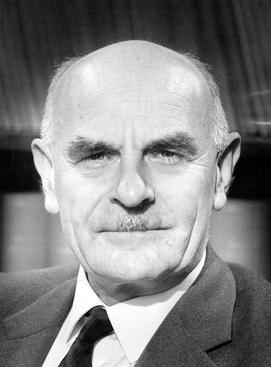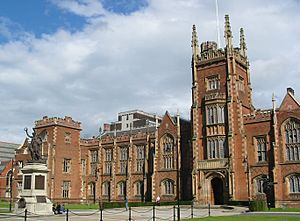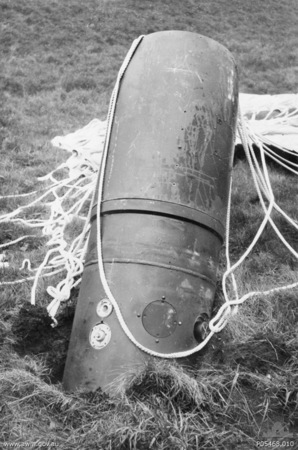Harrie Massey facts for kids
Quick facts for kids
Harrie Massey
|
|
|---|---|
 |
|
| Born | 16 May 1908 Invermay, Victoria, Australia
|
| Died | 27 November 1983 (aged 75) Esher, Surrey, England
|
| Alma mater | University of Melbourne Cambridge University |
| Awards | Hughes Medal (1955) Royal Medal (1958) knight bachelor (1960) |
| Scientific career | |
| Fields | Physicist |
| Institutions | Cavendish Laboratory Admiralty Mining Establishment Radiation Laboratory Queen's University of Belfast University College London |
| Thesis | The Collision of Material Particles (1932) |
| Doctoral advisor | Ralph Fowler |
| Doctoral students | Alexander Dalgarno David Robert Bates Ian Sloan Alan Martin Michael Seaton |
| Other notable students | G.D. Allam |
Sir Harrie Stewart Wilson Massey (16 May 1908 – 27 November 1983) was an Australian physicist. He mainly studied atomic physics and atmospheric physics. This means he looked at how tiny particles like atoms behave and how the Earth's atmosphere works.
Harrie Massey went to the University of Melbourne and Cambridge University. He earned his doctorate at the Cavendish Laboratory. In 1933, he became a teacher of Mathematical Physics at the Queen's University of Belfast. Later, in 1938, he became a professor at University College London.
During World War II, Massey helped develop ways to protect ships from German magnetic naval mines. He also helped create new British naval mines. In 1943, he joined the Manhattan Project. This was a secret project to build the first atomic bomb. He worked on separating different types of uranium at the Lawrence Berkeley Laboratory.
After the war, Massey returned to University College London. He became the head of the Physics Department in 1950. He helped focus the department on particle physics and studying the upper atmosphere. He also played a big role in developing British rockets, like the Skylark. He helped start important space science groups, including the European Space Research Organization.
Contents
Early life and education
Harrie Stewart Wilson Massey was born in Invermay, Victoria, Australia, on 16 May 1908. He was the only child of Harrie Stewart Massey and Eleanor Elizabeth Wilson. He grew up in a small community called Hoddles Creek.
He started school in 1913. By age nine, he had finished the eighth grade. However, he had to stay at the school for three more years because of his age. In 1920, he won a scholarship to University High School, Melbourne. He moved to Parkville, Victoria with his mother. At high school, he led the Science Club and was vice-captain of the cricket team.
University studies
At 16, Massey won another scholarship to the University of Melbourne. He started there in 1925. He first thought about studying chemistry. But he was very impressed by the physics lectures he attended.
He enjoyed playing sports at the university. He played cricket, billiards, tennis, and baseball. In 1928, he earned his Bachelor of Science (BSc) degree in physics. He got top honors. In 1929, he also earned a Bachelor of Arts (BA) in mathematics.
Massey met Jessica Elizabeth Bruce in 1925. They got married on 11 January 1928. They had one daughter, Pamela Lois.
At that time, the University of Melbourne did not offer a PhD degree. So, Massey worked on a Master of Science (MSc) degree. This included both experiments and theory. He worked with Courtney Mohr on X-ray studies. He also studied wave mechanics. This meant translating many science articles from German. His external examiner was Ralph Fowler from University of Cambridge.
Research at Cambridge
In 1929, Massey received a scholarship. This allowed him to go to Trinity College, Cambridge. He did research at the famous Cavendish Laboratory. Ernest Rutherford led this laboratory.
The Cavendish Laboratory was a world leader in physics. In 1932, scientists there made big discoveries. John Cockcroft and Ernest Walton split the atomic nucleus. James Chadwick found the neutron. Patrick Blackett and Giuseppe Occhialini confirmed the positron.
Massey earned his PhD in 1932. His research was about "The Collisions of Material Particles." Soon after, he wrote a book with Nevill Mott. It was called Theory of Atomic Collisions (1933). He also used collision theory to study neutron structure. While at Cavendish, he played hockey and cricket. He even captained the cricket team.
Teaching and new ideas
In 1933, Massey became a lecturer in Mathematical Physics. This was at the Queen's University of Belfast. He was the only person in his department for a year. He taught many lectures each week. Still, he found time to write another book, Negative Ions (1938).
He also started studying the upper atmospheric physics. Calculations were slow and tiring. So, he had a special machine built. It was a small differential analyzer. This was an early type of analog computer. It could solve complex math problems. He used it to study helium and oxygen in the atmosphere.
In 1938, Massey became a professor at University College London. He brought some of his colleagues with him. The differential analyzer also came to London. Sadly, it was destroyed during an air raid in World War II.
Second World War contributions
When World War II started in 1939, Germany began using naval mines. These mines caused a lot of damage to British ships. The mines were magnetic, meaning they exploded when a ship passed over them.
In December 1939, Massey joined a team at the Admiralty Research Laboratory. They worked on finding ways to stop these mines. They developed methods to clear the mines safely. This helped the Navy a lot.
By 1941, Massey became a lead scientist. His new job was to create British mines that were as good as the German ones. His team designed a mine called MX. It was soon used by the Navy. They also worked on mines that used sound or pressure to explode.
The Manhattan Project
In 1943, Massey was asked to join the Manhattan Project. This was a secret project to build the first atomic bomb. He traveled to the Lawrence Berkeley Laboratory in California.
His team worked on separating different types of uranium. This process was called electromagnetic isotope separation. Massey led the Theoretical Group. They studied how electricity behaves in magnetic fields. They also looked at uranium compounds. These were used to enrich uranium for the bomb.
In 1945, Massey took over as the head of the British mission in Berkeley. His team's wartime research was later published in a book.
Later life and space science
Massey returned to University College London in 1945. The university had been badly damaged by bombs. In 1950, he became the head of the Physics Department. He stayed in this role until he retired in 1975. He also served as the university's Vice-Provost from 1969 to 1973.

Under Massey's leadership, the Physics Department changed its focus. It moved towards particle physics and studying the upper atmosphere. He saw the importance of computers. He arranged for the department to get an early electronic computer.
Massey received many awards for his work. He became a Fellow of the Royal Society of London in 1940. He received the Hughes Medal in 1955 and the Royal Medal in 1958. He was also knighted in 1960 for his services to science.
Space exploration

Massey saw how rockets could help study the upper atmosphere. He became a strong supporter of space science. He even wrote a book about the history of British space science.
He led the Committee on Space Research (COSPAR) from 1959 to 1978. This group was important for international space research. He also helped start the European Space Research Organization. He helped found the Mullard Space Science Laboratory in London.
Massey visited Australia many times for space science projects. He helped test balloons for atmosphere research. He also worked on the British Skylark rocket. This rocket was tested in Woomera, Australia, in 1957. He wanted to create a UK space program with other countries. He helped set up the Anglo-Australian Telescope in New South Wales.
Massey received honorary doctorates from several universities. He was also a member of important scientific groups in the United States.
Death and legacy
Harrie Massey passed away on 27 November 1983, after a long illness. He was survived by his wife and daughter.
Many things are named in his honor. The Royal Society/COSPAR Massey Award is one example. There is also the Harrie Massey Lecture Theatre and Harrie Massey Prize at University College London. The Harrie Massey Medal and Prize is awarded by physics groups in Australia and Britain.
His childhood school, Hoddles Creek Primary School, named one of its houses "Massey house." A pine tree he planted there in 1937 is still standing. A plaque also remembers his achievements.



